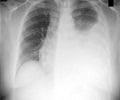
‘Delays in diagnosis were linked to a raised risk for disease complications, transmission of infection to household members.’
Read More..Tweet it Now
To minimize complications and prevent infection transmission, the WHO calls for initiating diagnostic workup and prompt treatment for all patients who have symptoms suggestive of active TB infection for two weeks or longer.Read More..
"The delays we found would be concerning under any circumstances, but they are unacceptable in a well-resourced health care system such as the United States," said study senior investigator Maha Farhat, assistant professor of biomedical informatics in the Blavatnik Institute of Harvard Medical School and a pulmonary medicine physician at Massachusetts General Hospital.
Researchers say one of the more likely drivers is lack of awareness among clinicians, possibly due to the rarity of TB in the United States.
Use of chest imaging and molecular diagnostic tests portended shorter time to diagnosis and treatment as did receiving care from an infectious disease or pulmonary medicine specialist.
"Our findings point to the key importance of continuing education of providers. We found several factors associated with delays and faster diagnosis," Farhat said "This tells us that delays are modifiable and preventable."
Advertisement
This observation hints that gaps in the ability to diagnose the disease early and treat it promptly may be important contributors, Farhat said.
Advertisement
Of the 18.9 million records in the database, the researchers identified 3,389 people whose records had diagnostic codes suggestive of TB. Of those, 738 individuals ended up getting an eventual diagnosis of active TB.
The median delay in TB diagnosis was 24 days, ranging from 10 to 45 days after initial visit for symptoms suggestive of the disease. Some cases, however, took far longer to diagnose -- more than 240 days in some instances.
Of the 738 patients with active TB, 65 developed respiratory complications, and those with delayed diagnoses were more likely to experience complications.
The median delay in diagnosis among patients who went on to develop one or more complications was around 32 days after first presentation to a doctor's office.
Those who did not experience complications were diagnosed and treated typically within 23 days. The most common complications included irreversible lung damage, collapsed lungs, fungal lung infections, and spitting blood, a symptom that heralds serious airway inflammation and injury.
Researchers analyzed the rate of infection among the household members of 456 patients with active TB who had one or more dependents covered by the same insurance.
Of those, 177 patients had another household member with latent TB. Of the 1,026 household members who cohabitated with a person with active TB, more than one-fourth (286) became infected. Further analysis showed that each additional week of delay in diagnosis boosted the risk for transmitting the infection by 20 percent.
Two patient categories appeared at greater risk for diagnostic delays -- older individuals and those with suppressed immunity.
The study did not examine the reasons behind this elevated risk, but the researchers said it may be because older individuals tend to have more variable, atypical presentation of symptoms or because clinicians may tend to attribute their symptoms to other lung diseases common in this group, such as COPD or pneumonia, for example.
Delayed diagnoses among immunosuppressed individuals may be due to atypical, variable symptoms or may stem from susceptibility to infections with multiple other organisms, which can reduce the number of TB cells present in a test sample and make laboratory confirmation of TB more difficult.
People who presented with three or more symptoms were more likely to be diagnosed more promptly than those presenting with fewer symptoms -- likely because the presence of more symptoms raised physician suspicion.
The use of chest X-rays or CT scans to image the lungs, the use of a molecular TB test called nucleic acid amplification, and receiving care from a TB specialist, all expedited diagnoses.
The bottom line for clinicians, Farhat said, is to err on the side of over-testing: The risk of missing TB far outweighs any possible downsides of ordering a fairly inexpensive molecular test or an X-ray to rule out TB disease.
"If you have a patient with cough, fever, shortness of breath, especially if they were born abroad or are an older individual, then you should be ordering a chest X-ray early and, if abnormalities are seen, a TB nucleic acid amplification test," she said.
"Yes, these are non-specific symptoms but the key is to think about it TB as a possibility and to remember that it is still present in the United States."
The researchers caution that their findings may not capture the full magnitude of delays because their analysis was based on a predefined set of variables contained in medical claim records.
The study design also did not allow researchers to track transmission outside of a patient's household, thereby likely underestimating transmission risk to others such as health care workers, for example.
De-identified nature of the data, may not allow researchers to capture important differences by race and ethnicity, which may be tied to delays in diagnoses and treatment, or country of birth, which confers different risk for TB.
"This is the advantage of big data," Farhat said. "Interrogated the right way, these records can give us a wealth of information about clinical care trends, without the need to mobilize additional resources for data collection."
Co-authors included Nathan Palmer, Michael McDuffie, Kathe Fox, Isaac Kohane, of Harvard Medical School, and Jonathan Golub of the Johns Hopkins Center for TB Research. Study first author Jessica El Halabi, now a resident at the Cleveland Clinic, conducted the work while a research associate in biomedical informatics at Harvard Medical School.
The work was funded by a T15LM007092 grant, by the Biomedical Informatics and Data Science Research Training Program, and by the National Institutes of Health/BD2K award K01 ES026835.
Source-Medindia












